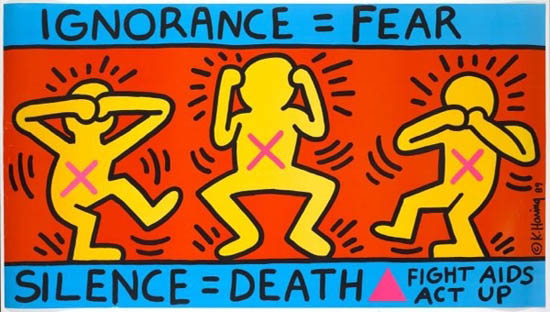A lot of people in my generation lack an understanding of the 1990's from a LGBT perspective, mainly because of our countries refusal to teach sex health and history to young people. However, in the 1980's and 1990's, LGBT people were dropping like flies because of the HIV/AIDs crisis. While today we see HIV/AIDs as manageable, in the recent past members of the LGBT were dying mysteriously and no one cared. For years, few attempts were made to figure out was killing so many gay people. AIDS was originally referred to as the GRID or Gay Related Immune Disorder and many thought it was god punishing LGBT for their sins. The Reagan administration failed to acknowledge the issue and one member was taped laughing about the epidemic. Do you know what gay people did? They acted. They kicked up storms of dust. They deployed sex like a tool to get attention, the embodiment of any press is good press. By going to the streets via art, sex, and plain old visibility. So when two dancers kiss in Truth or Dare it is for liberation and revolution, not Madonna.
When hooks states that Madonna cannot understand Black joy fully because she does not understand the pain it contrasts and the oppression it defies (158), she is also talking about members of the LGBT community. Madonna appropriates voguing because she appreciates it as an art form. However, Black gay and trans people started voguing as a space in which they could be themselves and perform their genders and not be threatened, but instead praised. Praised for their creativity, praised for their femininity, and praised for their 'realness'. So when Madonna takes voguing from its community and greater social context, she is stealing something more complex and important than a dance style. By relegating Black performers to stand a foot behind her, and by listing white celebrities as those to emulate in the song she is re instituting a system of white hegemony.
Yeah white women suffer from oppression at the hands of white man, but they have been huge contributors to perpetuating racism, especially in the name of overcoming sexism. So when Madonna responds to critique of her gay fetish with "What does exploitation mean?...In a revolution, some people have to get hurt. To get people to change, you have to turn the table over. Some dishes get broken" as bell hooks reproduces in her essay, she is echoing sentiments of white feminists before her. A few examples include, the white female abolitionists who reversed their opinions once they learned Black men may get the suffrage before them, the white women who got birth control legalized by citing it as a means to control populations of the poor, immigrant, and/or Black communities, or even the white middle class gay people who silenced voices like those of Sylvia Rivera and Marsha P Johnson after the Stonewall Revolution.
Madonna's attempts to liberate white female sexuality is admirable, but how many times do people of color have to lie down so white women can use the bridges of our backs to reach their own desired position. When is it our turn? Patricia Arquette's recent comments during her speech for winning the Oscar for Best Actress suggests the time came and went unnoticed and the cycle has started all over again. Funny enough, an Asian woman still hasn't won an acting award at the Oscars.
The thing about Madonna: Truth or Dare, is Keshishian, the director's ability to illuminate Madonna's use of the gay body of color as prop. Keshishian inter-cuts Queer Nation marching in the NYC Pride Parade (a much more radical space prior to the mid-2000s) with Oliver's homophobia. By doing so, Keshishian notes how depoliticized Madonna's touring Bubble is. She cries over Keith Harring's death of AIDs related complications, but does not name him until a voice over. She demurs when on the phone with her father or talking to her boyfriend Warren Beatty, but demands a Black crew member show her his penis on camera, and questions why one of her dancers even bothers to where underwear in bed with her. By placing these moments in black and white while filming her stage performance on stage in color, Keshishian exposes that Madonna is always performing. Though the film stock changes, her performance of self doesn't. It is a film of juxtapositions and contradictions, yet gives us a portrait of Madge that has breadth and depth. Maybe its ability to expose the totality of her private parts (hehehe) is why she can't watch the documentary to this day.




No comments:
Post a Comment
Note: Only a member of this blog may post a comment.